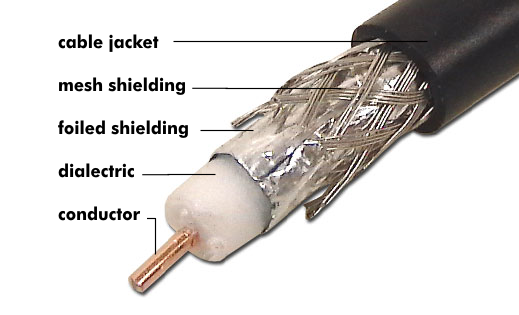dielectric
Dielectric is a non-conductive material used in capacitors and cables. It is a non-conductor whose atomic structure has no freely moving charge carriers. Dielectrics can be solids, but also liquids and gases.
Inelectronics and communications, dielectrics are used in capacitors, cables, antennas and connectors. In capacitors, it is the material that lies between the two electrodes; in coaxial cables or RF connectors, it lies between the inner conductor and outer conductor. Dielectrics used in capacitors can be non-conductive liquids such as oil, non-conductors such as ceramics, glass, plastic, mica (mica) or rubber, but also oxide layers and air. In high- frequency cables and RF connectors, on the other hand, plastics such as polyethylene( PE), polyvinyl chloride ( PVC), polypropylene( PP) or polytetrafluoroethylene(PTFE) are used.
The dielectric of cables
The properties of the dielectric are reflected in the dielectric constant or permittivity and have a direct influence on the capacitance of capacitors. This is due to the fact that the electric field strength is weakened in the dielectric.
In cables, the dielectric constant directly affects the transmission behavior of coaxial cables. Here, the dielectric significantly determines the characteristic impedance and the attenuation. Another characteristic value for dielectrics is their dielectric strength.
The dielectric of capacitors
In capacitors, the dielectric determines the frequency ranges in which the capacitors operate. Looking at different dielectrics, the plastics polycarbonate( PC), polypropylene (PP), polyester( PET), polytetrafluoroethylene (PTFE) and polystyrene( PS) support the largest frequency ranges between 0 Hertz up to the gigahertz range. Dielectrics made of glass or sintered ceramics can be used at low frequencies up to gigahertz frequencies. In contrast, mica is suitable for the kHz frequency range up to several hundred megahertz, and tantalum capacitors are generally in the low frequency range.
In addition to the dielectrics mentioned, there are metallized paper-based and plastic-based dielectrics. Capacitors on metallized paper are marked MP, those, with metallized plastic film are marked MK. And then there are the capacitors based on oxides, such as aluminuim oxide( Al2O3), tantalum pentoxide (Ta2O5) or niobium pentoxide (Nb2O5). In film capacitors, the temperature behavior of the dielectric affects the capacitance of the capacitor to a greater or lesser extent. The temperature properties of the dielectric are characterized by a three- digit letter-number combination. Well-known designations for these temperature properties of ceramic capac itors and multilayer ceramic capacitors( MLCC) are X7R, X8R, Y5V, and negative-positive-zero (NPO).
Dielectrics with permittivity greater than 4 are referred to as high-k dielectrics. These include silicon nitride( Si3N4), aluminum oxide (Al2O3) and titanium dioxide( TiO2). Such high-k dielectrics are used, among other things, in MIS capacitors(Metal Insulator Semiconductor) and integrated circuits.

